#ask-celts
Note
Genuine question, why do people think Scathath is so good at sex? Like yes she's a hot anime woman but is there any part of her character that I've missed that indicate any interest in sex?

#like many of the celts in actual lore. They love to fuck. Like at every opportunity or minor inconvenience. Scathach is among those people#Scathach in canon fucks her warriors she finds worthy (she actually didn't fuck cu in the tain though she considered it)#in the Scathach pre-release story in fgo. She offers guda an exclusive pass into her bedchamber if they're curious. An insane offer honestl#she also gives Fergus a shot in the release but she has him do the normal route which is defeat her in battle which he knows is a deathwish#fergus even contemplates that competing against Scathach with the reward of getting to fuck maybe worth dying for#know that Scathach in fgo generally contradicts her true desires all the time as a mask to appear more professional and teacher-like#she doesn't actually want to die. she wants to know what it's like to live again. as a mortal. to yearn for life#early fgo she showed a lot of disinterest as protocol but in truth she's actually super down to fuck as much as the other celts.#summer shishou will say she has no more interest in love at her age but literally moments after she'll be like what if we fucked as a bit 👀#nasuverse head game tourney#propaganda ask#ask
36 notes
·
View notes
Text
You guys keep falling for people going 'lol you're identifying the wrong way' wrt queer identities so I made you a flow chart
Is your anger against this label because it facilitates genuine harm towards others (eg. MAPs)? Godspeed and good luck to you.
Is your anger against this label because it is Using The Label Wrong and doesn't gel with your personal definition for this label (eg. MOGAI, bi lesbians, lesboys)? I'm sorry, but there's always gonna be people who identify in ways that you disagree with, and with something as intangible as queer identity, their stance has as much merit as your own. If you get ticked seeing someone IDing as both homosexual and bisexual, ask yourself if they're genuinely hurting anyone, and if not, let them be. You will never know the intricacies of someone else's identity, and if that's how they choose to define themselves, well, tough shit.
#like i id as both mspec and lesbian bcos i am genuinely unsure where the line is in my experiences#or if i even wanna draw the line#btw this isnt some holier-than-thou I Know Better thing this is also a reminder for myself#its been years and im still working on not reacting with vitriol when an american has irish heritage so they id as irish#like you do genuinely have to ask yourself 'what do i stand to gain from isolating myself from these people who want to bond with me'#and like its EASY to go 'i hate irish americans acting like they know ireland waheyyy fuck the yanks'#'theyre not even from here they dont know what ireland is like theyre not irelanders'#but at some point i realised that man. this just feels mean. i dont like this#irelands identity is based upon the people who live on the land. not the land the people live on#according to myth the first settlers werent the celts and they died out long ago and yet theyre still irish#and hearing someone discussing that myth go 'i think its wonderful that so many people share a heritage and appreciation for ireland'#'there are people in america and asia and africa who all have a claim to being irish'#'and acknowledging that is an important part to being irish'#and i thought man i WOULD like to acknowledge that it sounds nice#so when i see plastic paddy irish americans i Keep My Fucking Mouth Shut!#this is a memory but its also a metaphor for the queer community. hashtag words
174 notes
·
View notes
Note
On that post comparing Britain to Japan, you mentioned indigenous people. Out of genuine curiosity I want to know who indgineous people of Britain are. I know Japan's indigenous peoples are the Ainu, Emishi, and the Ezo, but I don't know what Britain's indigenous people are.
Ooh, thanks for asking!
Short answer: the Celts.
Longer answer: the Welsh, Scots, Manx, Cornish, Bretons and Irish—I’m including the the Irish even though (most of) Ireland is independent now because for most of the past 1500 years they’ve been under English rule (and Northern Ireland still is). The Bretons now live in northwestern France (Brittany) but they were originally from Britain and are also Celts. Basically all of the people who were living in the British Isles during the Roman invasion in the 1st century CE and the Anglo-Saxon invasion in the 5th century CE (around the same time the Romans left).
Here’s an article that talks a bit about the indigenous groups of Britain. If anyone has other resources or info, please add them!
Also, re: indigenous people in Japan, don’t forget about the Ryukyuans! Okinawa Prefecture used to be the independent Ryukyuan Kingdom until Japan annexed it and forced the king into exile in 1879. There have been efforts since the 70s to bring back Okinawan language and culture, since a lot of it was lost or forced underground when Japan took over.
#ask#history#england#celts#british history#british imperialism#japanese imperialism#yes I know all of this stuff about okinawa because of sk8 the infinity leaf me alone 😂
24 notes
·
View notes
Note
Neon a question: what genres of music/artists do you think Joe would vibe with?
i think joe is just generally a Music Fan. he has the most eclectic music taste you've ever heard. he'll play classical and edm and hiphop and folk and heavy metal all in a row and give you genre whiplash but enjoy it all equally. in all seriousness tho i think he just loves that music is so accessible now (he wouldn't have been able to listen to this much for so long!! nicky bought him a walkman when they first became a thing and joe carried it with him pretty much everywhere for about a month until it was damaged during a mission). in their safehouses they have various different selections of cds/cassettes/vinyls depending on what kind of player they have. if not joe has a couple ipods dotted around. he just likes music a lot
that being said i think joe likes blends of folk/traditional music or instruments with modern technology + styles especially, because he likes hearing how music grows and develops and how the instruments and styles he's heard for centuries are built on and adapted. (personal favourite examples are release by afro celt sound system which is a neat blend of electronic/celtic/african music and it slaps, literally any mashrou' leila song but especially taxi, shum by go_a and stefania by kalush orchestra. additionally kai tangata by alien weaponry for the maori metal which barely qualifies as an example but its cool and i'm on a roll.) hes also a big queen fan
i cant come up with an actual list because it will be heavily skewed towards me specifically (as a general Music Enjoyer). but yeah joe and music is important to me. i also think he's a big fan of any kind of love songs even the sappiest most terrible one you've heard in your life. he thinks theyre neat
#neon answers#spacegirlsgang#obligatory i know ive had this ask forever oops#anyway. i know i brought up mashrou leila but it was impossible not to i think joe would vibe with it. also i just think they're neat. i#know i'm projecting here but thats ok#joes actual favourite musician is nicky <3#nicky i think has a slightly more specific music taste. hes very old man about it. also a Vinyl Guy whereas joe doesnt care what media the#music is on as long as he can listen to it#nile very much likes more modern stuff but there are some classical pieces she absolutely loves#andy will listen to anything with a beat. she's not a slow songs kind of person she needs to be able to hear the drums#she's less of a recorded music person but she does love communal playing#booker is similar to nicky in a way. i think he likes 30s/40s/50s stuff generally but does like some modern things. also a Vinyl Guy#anyway. i like music a lot#the aforementioned afro celt sound system song is really interesting musically. theres cool stuff in there#addition: andy tends to prefer the more upbeat stuff you can move to. not as big of a fan of slow songs but she likes a few#anyway if you want Weird Song Recs or recs in a specific language. i have many#/ specific genre. again i have many#neon talks music#i WILL namedrop meteor airlines tho for the contemporary amazigh stuff. it's awesome. think joe would like it#there's not many english songs / artists named but i do think joe would be a hozier or mika enjoyer. again projecting#anyway in short: please always ask me about music i love talking about it
19 notes
·
View notes
Text
AIght all the apoc gang rank ups are done! Now to just roll them out as I can...
#And then lets see I also explicitly said i'd do one for both Diarmuid's#and the rest of the lancer celts and the cu's#and I wanna do ones for the Argonauts too so that's at the very least#medea and Heracles and Caeneus#mayyyybe i'll do circe and asclepius but maybe not#someone asked about Izou#and then there's Phantom his is way too thought out to not discuss#same goes for Valkyrie. MAYBE for Sanson's....#lastly there's all 3 medusas and Lalter for AG#Nightingale too#hypothetical rank ups#and I believe that's at least all the ones I made obligations towards
16 notes
·
View notes
Text
Me: Oh, I haven't done much with War WItch's worlbuilding. Just some vague ideas and interesting concepts I want to pursue.
Also me: *immediately upon waking* Hey babe, let me rant at you about the animal husbandry practices of the Aillan people, the specific breeds of livestock they would keep, and how their respect for nature and spiritual beliefs affect how they approach problems like wild animal depredation and land ownership - ie pastures and fields. OH, and here is a very, very brief and vague explanation of the Koric and Suaythen Empires' colonization of the Aillan people, and a rough geographic breakdown of the historic territories of the Aillan.
#k writes#WIP: War Witch#it's one of those days#I come from an agricultural background#and researching historical breeds of livestock is just hitting something in me#ive gone off the deep end#someone ask me about cattle and the ancient celts
3 notes
·
View notes
Note
Random fact about hair dye perhaps?
The first definitive use of hair dye was the ancient scots bleaching their hair blonde. Many people found this practice terrifying. For example, the greek historian, Diodorus Siculus (amazing name, by the way) wrote this about the Celts in one of his books: "Their aspect is terrifying... They are very tall in stature, with rippling muscles under clear white skin. Their hair is blond, but not naturally so: they bleach it, to this day, artificially, washing it in lime and combing it back from their foreheads. They look like wood-demons, their hair thick and shaggy like a horse's mane.”
8 notes
·
View notes
Note
if you're gonna watch britannia fair warning the best way to enjoy it is if you don't take it seriously at all, i personally loved the show but boy does it get soooooo ridiculous
lol the opening screen saying that julius caesar never invaded britain because 'the druids' scared him very much set the tone. im going to give it a few episodes because ultimately im willing to overlook silliness if i like the characters or think there's a justification for it
#tbh the second i saw it involved celts my expectations were adjusted lol#ask#anon#but i hope i at least have fun
0 notes
Note
Drunk ama! Who do you wish was in the hot tub with you?
Is this like the "pick a famous person from any moment in time to have dinner with" question but with hot tubs because like... that really changes the whole dynamic to the question because there are plenty of people I'd have dinner with but wouldn't want to hot tub with because if there's one thing I've learnt about hot tubs it's that you gotta be alright with at least some leg touching, there's a lot of leg touching
Anyway it's boudicca
#like can you even imagine#she could do with some relaxation#we could talk shit about romans too#she could teach me some cool facts about the celts#interviews in a hot tub would be quite a fun concept#im open to hot tub suggestions now#who wiuld you hot tub with?#me#ask answered#ask rambly answered#aorry haha
0 notes
Text

This Meme!
Anonymous Inquired: “Don’t you feel any guilt?” For Lycoris


Guilt? Was this poor soul honestly asking her if she happened to feel guilt? The mere thought of it was enough to draw the most amused of laughs from her. With the things that she had done, if she was capable of feeling guilt she either was exceptionally good at ignoring that emotion or would have likely set off to find a way to prevent herself from continuing. But here we all were, with her laughing and a poor soul's limp corpse wrapped up in her chains. And we won't go into any further depth on that mess than this.
" Why would I? " Her response was swift, and held no hesitation in the slightest. " All I'm doing is having fun, why would I feel guilt over that~? Maybe I should include you in on the fun! Maybe then you'll understand. "
#[ events that test the resolve to follow || asks ]#[ those once bound by word and law testing as they please || ic ]#[ lycoris ]#anonymous#Yes#Having Celt has made things worse with her#[ ancient oaths given left to weather times passage || queue ]
1 note
·
View note
Note
Do you like carbonated drinks/citrus juices/green tea?
Yes, yes and I only drink black tea to appease the half that is my english ancestors
0 notes
Text

So I got this tag on my answer to an ask about when it became acceptable for western women to wear pants, and you know it's all I need to go on a tangent.
I think the short answer here would be men have worn skirts as long as people have worn anything, so pretty long tbh. But since I am incapable of answering anything shortly, I think we can re-frame this question:
When did skirts stop being socially acceptable for men?
So let's start with acknowledging that tunics, togas, kirtles and such men wore through history were, in fact, skirts. I think there's often a tendency to think of these as very different garments from those that women wore, but really they are not. Most of the time they were literally referred to with the same name. (I will do a very broad and simplified overview of men's clothing from ancient times to Early Middle Ages so we can get to the point which is Late Middle Ages.)
Ancient Greek men and women both wore chitons. Even it's length wasn't determined by gender, but by occupation. Athletes, soldiers and slaves wore knee-length chitons for easier movement. Roman men and women wore very similar garment, tunics. Especially in earlier ancient Rome long sleeves were associated with women, but later became more popular and unconventional for men too. Length though was still dependent on occupation and class, not gender. Toga was sure men's clothing, but worn over tunic. It was wrapped around the waist, like a dress would, and then hung over shoulder. Romans did wear leggings when they needed to. For example for leg protection when hunting as in this mosaic from 4th century. They would have been mostly used by men since men would be doing the kinds of activities that would require them. But that does not lessen the dressyness of the tunics worn here. If a woman today wears leggings under her skirt, the skirt doesn't suddenly become not a skirt.
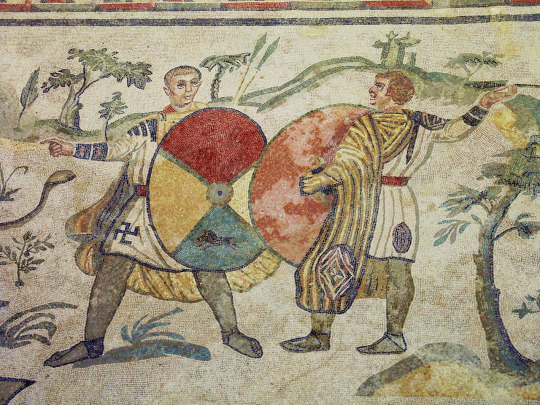
All over Europe thorough the early Middle Ages, the clothes were very similar in their basic shape and construction as in Rome and Greece. In Central and Northern Europe though people would wear pants under shorter tunics. There were exceptions to the everyone wearing a tunic trend. Celtic men wore braccae, which were pants, and short tunics and literally just shirts. Celts are the rare case, where I think we can say that men didn't wear dresses. Most other peoples in these colder areas wore at least knee-length tunics. Shorter tunics and trousers were worn again mostly by soldiers and slaves, so rarely any other woman than slave women. The trousers were though definitely trousers in Early Middle Ages. They were usually loose for easier construction and therefore not that similar to Roman leggings. However leggings style fitted pants were still used, especially by nobility. I'd say the loose trousers are a gray area. They wore both dresses and pants, but still definitely dresses. I'd say this style was very comparable to the 2000s miniskirts over jeans style. First one below is a reconstruction of Old Norse clothing by Danish history museum. The second is some celebrity from 2005. I see no difference.
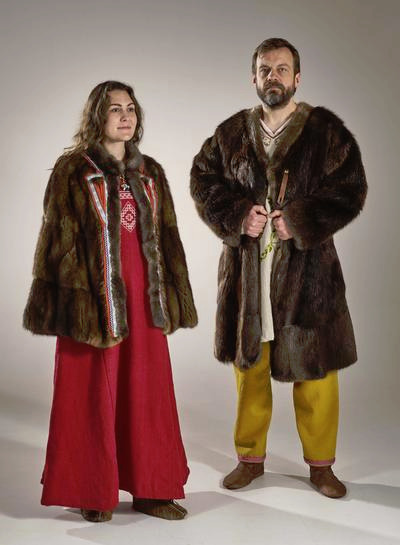

When we get to the high Middle Ages tunics are still used by both men and women, and still it's length is dependent on class and activity more than gender, but there's some new developments too. Pants and skirt combo is fully out and leggings' are back in in form of hose. Hose were not in fact pants and calling them leggings is also misleading. Really they are socks. Or at least that's how they started. As it has become a trend here they were used by everyone, not just men. During early Middle Ages they were worn often with the trousers, sometimes the trousers tucked inside them making them baggy. In high Middle Ages they became very long when used with shorter tunics, fully displacing the need for trousers. They would be tied to the waist to keep them up, as they were not knitted (knitting was being invented in Egypt around this time, and some knitting was introduced to Europe during middle Ages, but it really only took off much later during Renaissance Era) and therefore not stretchy. First picture is an example of that from 1440s. Another exciting development in the High Medieval era was bliaut in France and it's sphere of influence. Bliaut was an early attempt in Europe of a fitted dress. And again used by both men and women. The second illustration below from mid 12th century shows a noble man wearing a bliaut and nicely showing off his leg covered in fitted hose. Bliaut was usually likely fitted with lacing on the sides, but it wasn't tailored (tailoring wasn't really a thing just yet) and so created a wrinkled effect around the torso.
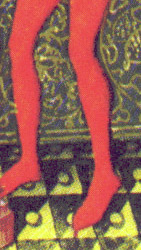

In the 14th century things really picked up in European fashion. European kingdoms finally started to become richer and the rich started to have some extra money to put into clothing, so new trends started to pop up rapidly. Tailoring became a thing and clothes could be now cut to be very fitted, which gave birth to fitted kirtle. At the same time having extra money meant being able to spend extra money on more fabric and to create very voluminous clothing, which gave birth to the houppelande.
Kirtle was once again worn by everyone. It wasn't an undergarment, for women that would be shift and men shirt and breeches, but it was an underlayer. It could be worn in public but often had at least another layer on top of it. The bodice part, including sleeves were very fitted with lacing or buttons (though there were over-layer kirtles that had different sleeves that changed with fashions and would be usually worn over a fitted kirtle). Men's kirtles were short, earlier in 14th century knee-length but towards the end of the century even shorter styles became fashionable in some areas. First picture below shows a man with knee-length kirtle from 1450s Italy.
Houppelande was also unisex. It was a loose full-length overgown with a lot of fabric that was gathered on the neckline and could be worn belted or unbelted. The sleeves were also wide and became increasingly wider (for men and women) later in the century and into the next century. Shorter gowns similar in style and construction to the houppelande were also fashionable for men. Both of these styles are seen in the second picture below from late 14th century.
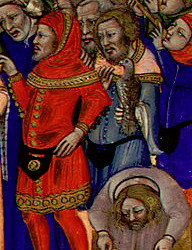

In the very end of 14th century, first signs of pantification of men can be seen. In France and it's sphere of influence the skirt part of the kirtle became so short it barely covered the breeches as seen below on these fashionable musicians from 1395-1400 France. Long houppelandes, length ranging from floor to calf, were still used by men though (the second picture, 1414 France), as were knee and thigh length gowns of similar loose style.

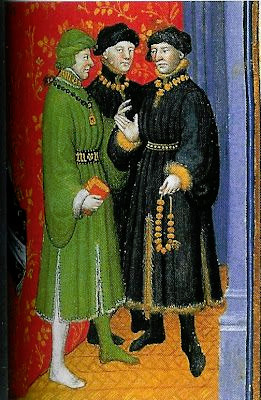
The hems continued to be short through the 15th century in France, but in other places like Italy and German sphere of influence, they were still fairly long, at least to mid thigh, through the first half of the century. In France at some point in late 13th century the very short under-kirtle started to be called doublet and they are just getting shorter in 1400s. The showing underwear problem was fixed by joined hose and the codpiece, signaling the entrance of The Sluttiest Era of men's fashion. Below is an example from 1450s Belgium of doublet and early codpiece in display. As you can see from the other figures, the overgowns of the previous century were also getting very, very short. In the next French example below from 1470s we can see the skirt shrink out of existence right before our eyes.
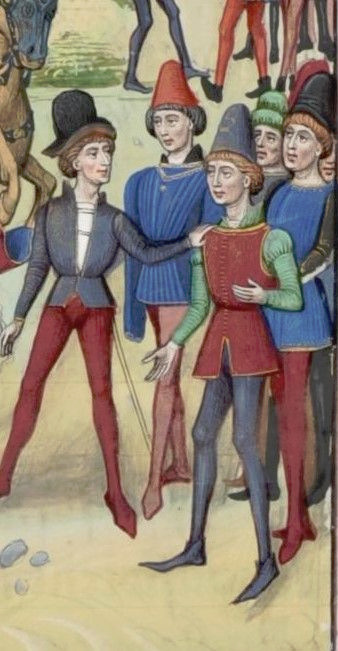

The very skimpy doublet and it's accompanying codpiece spread to the rest of the Europe in the second half of 15th century and it would only get sluttier from there. The Italians were just showing their full ass (example from 1490s). The dress was not gone yet though. The doublet and codpiece continued to be fashionable, but the overdress got longer again in the French area too. For example in the second example there's Italian soldiers in a knee length dresses from 1513.
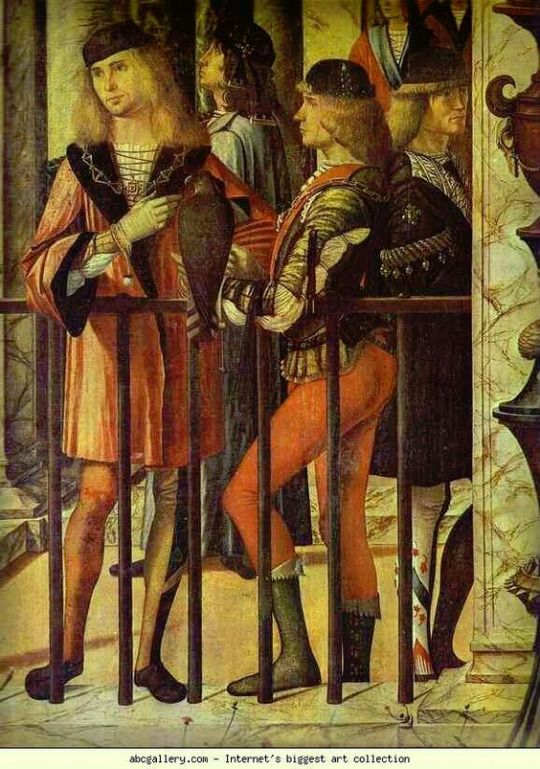
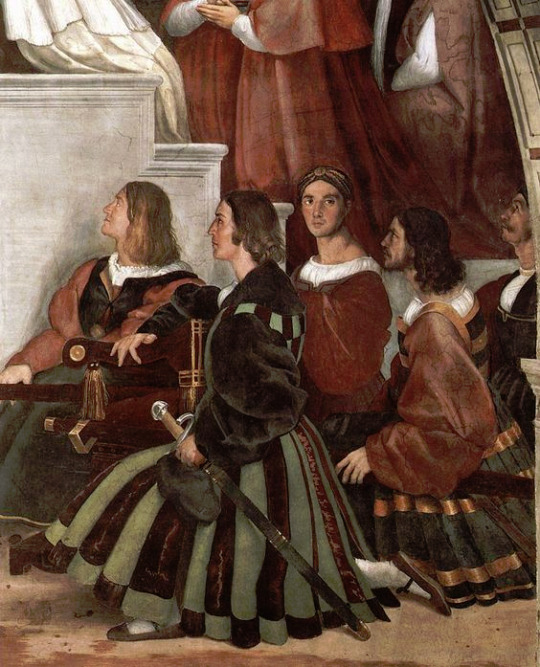
But we have to talk about the Germans. They went absolutely mad with the whole doublet and codpiece. Just look at this 1513 painting below (first one). But they did not only do it sluttier than everyone else, they also changed the course of men's fashion.
Let's take a detour talking about the Landsknecht, the mercenary pikeman army of the Holy Roman Empire. (I'm not that knowledgeable in war history so take my war history explanation with a grain of salt.) Pikemen had recently become a formidable counter-unit against cavalry, which earlier in the Medieval Era had been the most important units. Knights were the professional highly trained cavalry, which the whole feudal system leaned against. On the other hand land units were usually not made of professional soldiers. Landsknecht were formed in late 15th century as a professional army of pikemen. They were skilled and highly organized, and quickly became a decisive force in European wars. Their military significance gave them a lot of power in the Holy Roman Empire, some were even given knighthood, which previously wasn't possible for land units, and interestingly for us they were exempt from sumptuary laws. Sumptuary laws controlled who could wear what. As the bourgeois became richer in Europe in late Middle Ages and Renaissance Era, laws were enacted to limit certain fabrics, colors and styles from those outside nobility, to uphold the hierarchy between rich bourgeois and the nobles. The Landsknecht, who were well payed mercenaries (they would mutiny, if they didn't get payed enough), went immediately absolute mad with the power to bypass sumptuary laws. Crimes against fashion (affectionate) were committed. What do you do, when you have extra money and one of your privileges is to wear every color and fabric? You wear every color and fabric. At the same time. You wear them on top of each other and so they can be seen at the same time, you slash the outer layer. In the second image you can feast your eyes on the Landsknecht.


Just to give you a little more of that good stuff, here's a selection of some of my favorite Landsknecht illustrations. This is the peak male performance. Look at those codpieces. Look at those bare legs. The tiny shorts. And savor them.
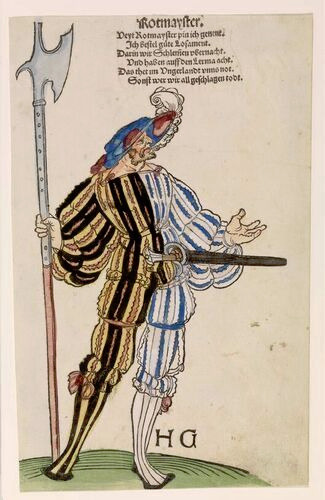
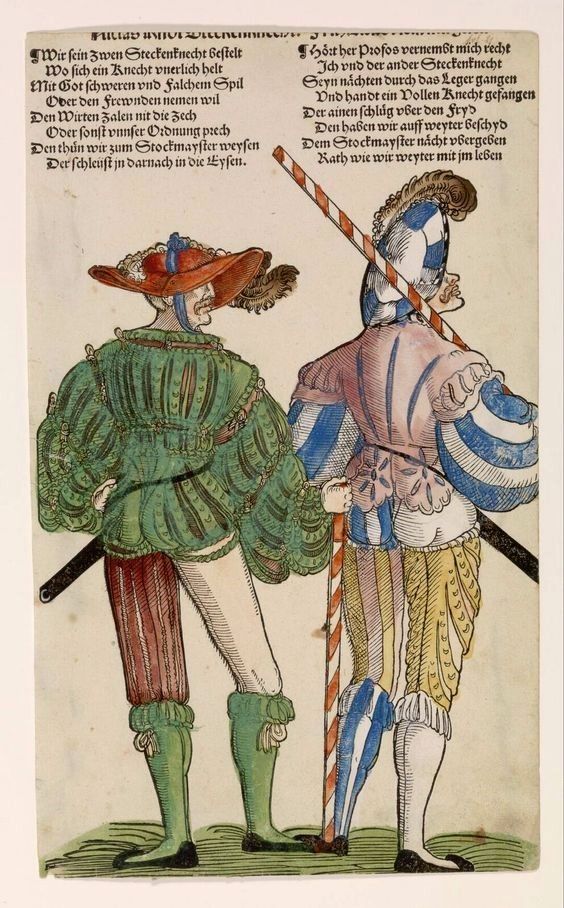
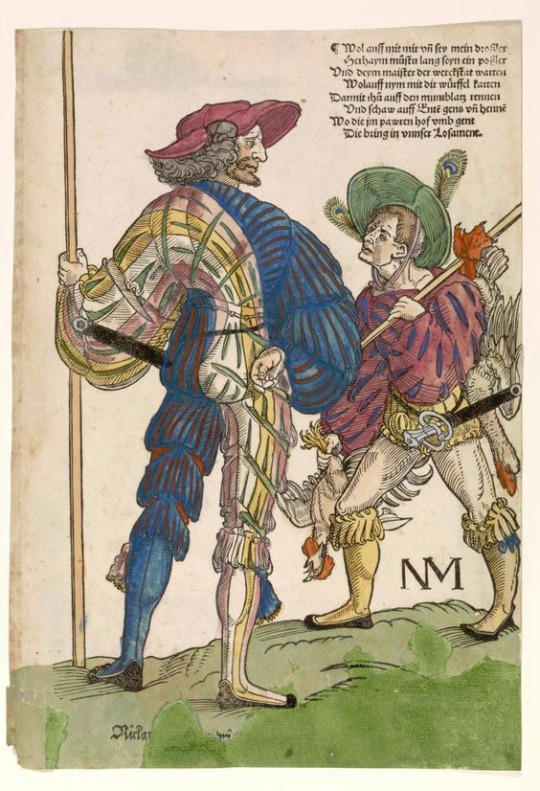
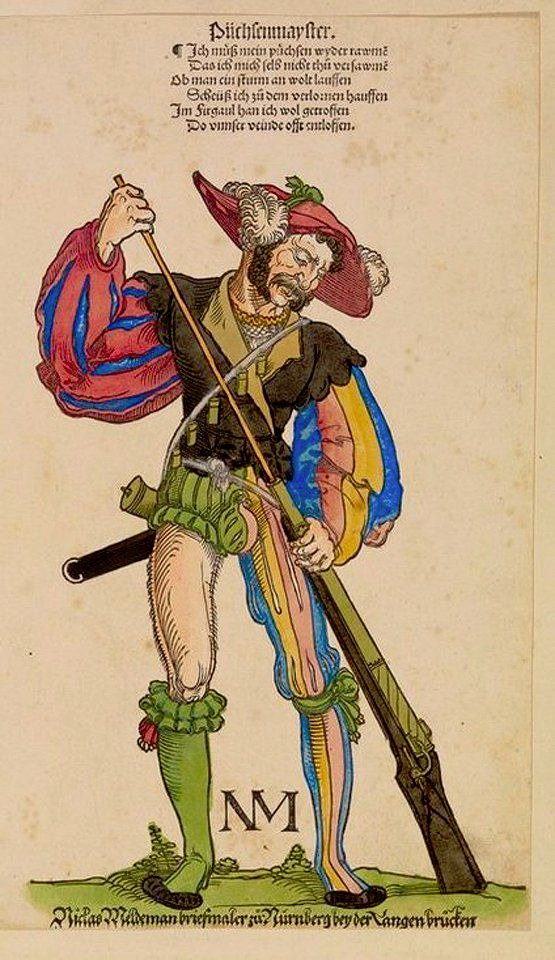
The Landsknecht were the hot shit. Their lavish and over the top influence quickly took over men's fashion in Germany in early 1500s. Slashing, the technique possibly started by them, but at least popularized by them, instantly spread all over Europe. That's how you get the typical Renaissance poof sleeves. They at first slashed the thighs of their hose, but it seems like to fit more of everything into their outfits, they started wearing the hose in two parts, upper hose and nether hose, which was a sort of return to the early Medieval trousers and knee-high hose style. The two part hose was adopted by the wider German men's fashion early in the century, but already in 1520s had spread to rest of Europe. It was first combined with the knee-length overdress that had made it's comeback in the turn of the century, like in this Italian painting from 1526 (first image). At this point knitting had become established and wide-spread craft in Europe and the stockings were born, replacing nether hose. They were basically nether hose, but from knitted fabric. The gown shortened again and turned into more of a jacket as the trunk hose became increasingly the centerpiece of the outfit, until in 1560s doublet - trunk hose combination emerged as the standard outerwear (as seen in the second example, 1569 Netherlands) putting the last nail on the coffin of the men's dress as well as the Sluttiest Era. The hose and doublet became profoundly un-slutty and un-horny, especially when the solemn Spanish influence spread all over with it's dark and muted colors.


Especially in Middle Ages, but thorough European history, trousers have been associated with soldiers. The largely accepted theory is that trousers were invented for horse riding, but in climates with cold winters, where short skirts are too cold, and long skirts are still a hazard when moving around, trousers (with or without a short skirt) are convenient for all kinds of other movement requiring activities like war. So by adopting hose as general men's clothing, men in 1500s associated masculinity with militarism. It was not a coincidence that the style came from Landsknecht. I may have been joking about them being "peak male performance", but really they were the new masculine ideals for the new age. At the time capitalism was taking form and European great powers had begun the process of violently conquering the world for money, so it's not surprising that the men, who fought for money and became rich and powerful doing so, were idealised.
Because of capitalism and increasingly centralized power, the feudal system was crumbling and with it the feudal social hierarchy. Capitalism shifted the wealth from land ownership (which feudal nobility was built upon) to capital and trade, deteriorating the hierarchy based on land. At the same time Reformation and centralized secular powers were weakening the power of the Church, wavering also the hierarchy justified by godly ordain. The ruling class was not about to give up their power, so a new social hierarchy needed to form. Through colonialism the concept of race was created and the new hierarchy was drawn from racial, gender and wealth lines. It was a long process, but it started in 1500s, and the increasing distinction between men's and women's fashions was part of drawing those lines. At the same time distinctions between white men and racialized men, as well as white women and racialized women were drawn. As in Europe up until this point, all over the world (with some exceptions) skirts were used by everyone. So when European men fully adopted the trousers, and trousers, as well as their association to military, were equated with masculinity, part of it was to emasculate racialized men, to draw distinctions.
Surprise, it was colonialism all along! Honestly if there's a societal or cultural change after Middle Ages, a good guess for the reason behind it is always colonialism. It won't be right every time, but quite a lot of times. Trousers as a concept is of course not related to colonialism, but the idea that trousers equal masculinity and especially the idea that skirts equal femininity are. So I guess decolonize masculinity by wearing skirts?
#this has been sitting in my drafts almost finished for like a year or something#historical fashion#fashion history#fashion#history#dress history#men's historical fashion#renaissance fashion#medieval fashion#western fashion#western fashion history#landsknecht
3K notes
·
View notes
Note
(Apologies if this is outside your normal ask) why weren't weapons like spears and pikes made entirely out of bronze/iron/whatever metal the army used?
Since (depending on the army) many of them are already given a sword as a sidearm, is also having a spear made out of iron (so it won't break as easily) too expensive? Or is it a weight issue?
I'm pretty sure I've seen a few that were, but they're fairly rare. Weight is a serious consideration, especially for bronze weapons, but that wasn't the real problem.
Ironically, the wooden shaft is sturdier than an equivalently sized iron or bronze shaft would have been. A major problem for longswords in the early iron age was that they tended to bend from use. There's even a Roman account from combat with the Celts, where the Celts were using bronze longswords, and had to re-straighten their weapons on the battlefield because they were becoming bent and breaking.
In fact the Romans specifically designed a non-reusable javelin (the pilum), which exploited this issue. The pilum had an abnormally long head (roughly 60cm) When the pilum struck its target, the head would bury into the target normally, but the weight of the grip would cause the iron shaft to deform, rendering the weapon unusable.
The other side of this is that, as mentioned, wood is a lot tougher than people seem to think. I'm not sure where this idea that you could just casually chop through someone's spear with a sword came from, but as anyone who's ever tried to chop down a tree can tell you, yes in a fight between wood and metal, metal will win, but it takes a lot of effort to get there. Cutting through someone's spear with a single slice just isn't happening. That's not how wood works, and that's not how swords work. Though, attempting to do so is a good way to mangle your blade.
Wooden spear shafts were reasonably durable, and easy to replace. Bronze or iron shafts were neither.
Eventually, I think this was the 19th century, hollow steel shafts were used by cavalry. At that point in time you were looking at shafts that were significantly more durable than the wooden ones, and were cheap enough to produce that they could be easily fielded. Unfortunately, this only lasted a few decades until the proliferation of fully automatic firearms ended cavalry charges definitively. In another bit of irony, the technological advancement that allowed for effective metal spear shafts, is the same advancement that rendered them obsolete.
I think there were some iron reinforced shafts used by some cavalry forces before that, but I can't remember (nor can I quickly find) who might have been using those.
These days, hollow aluminum shafts are pretty common in javelins, and arrows, and they are generally superior to wooden shafts, however, the method to produce metallic aluminum wasn't discovered until the 19th century.
So, the short answer, wooden shafts were better. They were sturdier and easier to replace.
-Starke
This blog is supported through Patreon. Patrons get access to new posts three days early, and direct access to us through Discord. If you’re already a Patron, thank you. If you’d like to support us, please consider becoming a Patron.
298 notes
·
View notes
Text
Jewish-Celtic Similarities
So I know I'm late to this, but a while back @nattitavi asked me to please tell more about Jewish-Celtic similarities. This is something that I, too, have some interest in. For context, I'm an American Jew with some Celtic ancestry (my dad's family is """Irish""") and am now living in a Celtic country (not Ireland-don't want to say where exactly I live on the internet). Unfortunately, I don't know of any "scholarly" resources on this topic, but there are some similarities I can think of off the top of my head and have heard brought up in discussions:
Both are communal cultures in which the people help each other out.
Historical dependence on sheep
Indigenous peoples who take responsibility for nature
Long history of persecution and being colonized
Many Celtic rock groups have a lot of Jewish fans and sometimes Celtic rock songs happen to have Jewish themes. For example, to me at least, the song "In a Big Country" by Big Country is clearly about Shoah survivors making new lives for themselves in Israel (but then shouldn't it be called in a small country?), "The Storm", also by Big Country, despite explicitly being about the battle of Culloden just makes me think of 7/10 whenever I listen to it since then, and "Blood" by Dropkick Murphys seems like a good song for Purim (or really any holiday that's "they tried to kill us, we survived").
Using the tree of life as a symbol (although that exists in other cultures, too).
There are some linguistic similarities between Celtic and Semitic languages! I actually do have a source for this: https://www.youtube.com/watch?v=OAAmwtdP1bE
Could the Celts be one or more of the lost tribes? There's some speculation about this that's in the realm of conspiracy theories, but I think it's possible.
172 notes
·
View notes
Note
Is PHH Melusine’s mother Pressyne is going to be a fairy who got born from Albion’s band?
man you are asking the wrong guy with this one
2 notes
·
View notes
Text
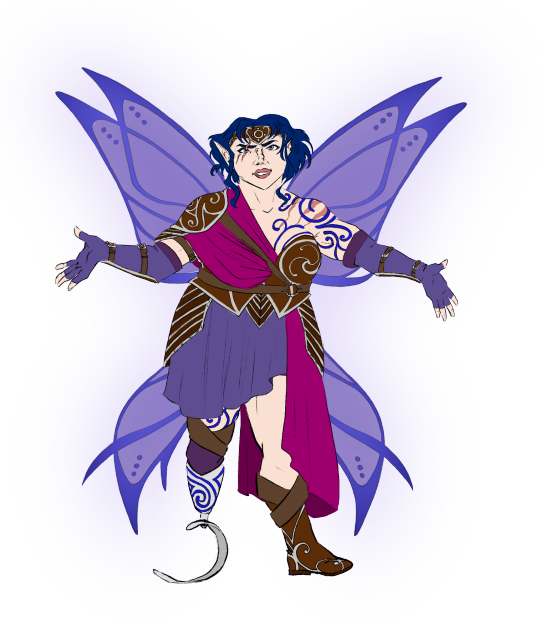



The Grand Mages, my version of The Major Fairies in my Winx rewrite.
The reason for the term Mages instead of Major Fairies is that they weren’t all Fairies throughout history and it isn’t a requirement that they be fairies either. The reason for them all being fairies now is that they’re simply the most common group of magic users left on Earth currently after the great scourge of death and purging magical beings experienced on the planet.
The Grand Mages are chosen by The Grand Council, the delegation for magical beings on Earth, which is now on Tír na nÓg presently.
The current Grand Mages are as follows, some with a lot of info (mainly Sybilla) and some with simple brief descriptions, including so e job descriptions, personal histories, believix info and general lore below the cut:)
Nebula, Grand Mage of Peace. Her title is kept all throughout her history, not changed like it is in the series to war, for peace comes as the end goal, and to that with the Grand Mage title, if war is needed to achieve that, then so be it.
She is the second youngest, older than Aurora by about 900 years, born around the year of what we would call 400 CE. She is around the same age as Morgana, only a few years younger.
She would be classified as one of the Picts in the eyes of humans, born in what would later become known as the area of Scotland at the time before the Celts. As I mentioned in my first ask with her, I know there are issues of debated anachronism regarding The Picts and blue war paint, but it fit her color palette and I thought it looked cool on her so we’re going to say it was indeed a thing in this version of history, but as a result of the magical beings there mainly being the ones who utilized it.
As also mentioned in my original ask with her, she doesn’t always use her magic to treat her wounds, taking certain pride in her battle scars, showing them as a way to say “you see? No matter how many times you try to beat me down, I cannot be quashed. You cannot best me, I will always retaliate and I will always come back and so long as I am alive, I will win.”
Aurora is The Grand Mage of The North, a title given to the being who guards the Lovix transformation. She is the youngest of the current Grand Mages, being only 700 years old. It is her job to preside over the domain that Lovix is connected to (the areas of what are labeled as Fennoscandia) for if the connection to the areas the transformations were birthed from is severed or lost, those transformations cannot be accessed anymore. Her dedication, quick wit, and drive to protect and honor the land her master, The Grand Mage of The North before her guarded, is what lead to her being selected as the next one despite her relatively young age when compared to the other magical beings who served under the previous Grand Mage. This retired Grand Mage now lives at the small community that is located in what we would call Northern Sweden in the wilderness that she and the other followers dedicated to this cause call their home. This area acts as their headquarters of sorts.
Aurora is in change of overseeing all areas of Earth’s Northern Hemisphere and doing what she can to ensure general harmony with the energy of the planet and its environment, with her main focus being on guarding that area Lovix is tied to. Her primary way of combatting any serious issues humans intact on the environment and any disruption they cause is through the use of environmental influence, such as extreme cold, blizzards, long winters, early frosts, etc, causing things like famine, poor harvests, or direct death from the elements.
Diana is The Grand Mage of The South, her main location insulated to where she was born in what is referred to as modern day Bolivia. Sophix is connected to what is known today as The Amazon Rainforest, and this area must be protected with regard to the transformation for the same reason as Lovix. Much like Aurora, she is also in charge of doing what she can to ensure general harmony with the nature and environment of the southern hemisphere of Earth’s planet.
A strong warrior and combatant, she has resorted to more direct force as a tactic to deal with the issues humans have been enacting on the planet, doing what she can to still stay as hidden from them as possible while attacking, or leaving no survivors. Her and Nebula are close, a love of sparring and battle strategy being a large basis for what they choose to do in any of the spare time they manage to have together.
She is the second oldest of The Grand Mages.
Sybilla is the oldest of The Grand Mages.
Her wings are present here, but she doesn’t usually have them out, simply not seeing a need to most of the time.
Lady of Justice is the title given by those of the order of Tír na nÓg, and this was the title given to her by many, magical and non magical, even before all magical beings were either sequestered away to there, killed, fled, or managed to blend in with the non magical beings.
She is much more elusive than the other Grand Mages and despite her very present record in that of history, she isn’t one to be easily reached, only deciding herself if it is worth it, answering to no single allegiance, creed, nation, etc. She is included in the category of The Grand Mages mainly by the choosing of the other Mages, and only agrees within her own terms to be accounted for as such.
Parts of magical history intermingle with non magical history in my thing. Her influence is felt in artwork, dress, customs, and tales from Greco-Roman antiquity, and even the time before that, during the eras of The Bronze Age with the Cycladic, Minoan, and Mycenaean civilizations, and then even before that.
Much like the term irl, Sybilla is a term that simply means prophetess and sprung forth to give to the term sybil, those being what they are in our real world tales too. In my thing tho, this term stems from her name first and went on to become synonymous and defined as prophetess.
There were other sybils just like in old stories, these being followers of hers who wanted to act in her stead and honor and provide their services too.
Sybilla is the supreme head though, and is the grand origin for this.
She goes into stasis for longer periods of time so despite being the oldest, turning to stone by choice, this time acting a long sleep for her. When she awakes, it feels like she has only blinked. Sometimes towns would be built around her stony form, alters erected around her, offerings brought, pilgrimages made. And then suddenly, the mortals will see her “statue” is suddenly gone, and when she chooses to rest again, the cycle begins anew. Sometimes new statues are erected where she used to rest, legends telling that it actually is her and not just a statue, others believing it was just a statue put there long ago and someone decided to steal it so a new one must be placed.
There are many of her form in many places for that reason among other, her acting as a type of saint or figure to be kept to watch over places or people or whatever is deemed to need watching, memorabilia of her present in the forms of previously memorials statues, small talisman type objects, her figure on handkerchiefs, tapestries, walls of buildings, etc.
She has a history of intermingling with non magical beings far more than any of the other Grand Mages, even more so than most magical beings in general. With regard to that and her actions, she chooses to sleep when she feels she has done her job for the time being, overseeing and acting as whatever the mortals feel she is during times of great strife, whether that label be as a guide, an oracle, a prophet, or sometimes even a god or goddess.
She also chooses to rest after helping with grand issues with magical affairs too just the same. She awakens when she chooses to, whether that be because something in the ambient energy of the Earth feels off, signaling a great change, she has been sought out by a being, magical or not, that has made a great plea that she deems worthy, or she has decided she simply doesn’t want to rest anymore.
Her form appears through much of human history in the areas of the modern day Mediterranean and she has many stories about her weaved through old long gone told tales and legends, many lost to time, some still present.
Her aging is less visible than on Diana as a result of her sporadic periods of stasis, who has stayed active and present for her whole life, which has resulted in peak milf status.
She has no eyes, having had them voluntarily removed to be fully dedicated to her cause of what she deems proper judgement and action.
#winx club#winx#winx club nebula#winx nebula#nebula winx#winx club aurora#winx aurora#aurora winx#Diana winx#winx club Diana#winx Diana#sybilla#Sybilla winx#winx Sybilla#Sybilla winx club#believix#world building#lore#winx club rewrite#winx rewrite#winx club redo#winx redo#winx club remake#winx remake#winx club redesign#winx redesign
178 notes
·
View notes